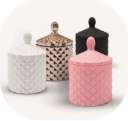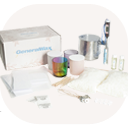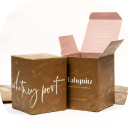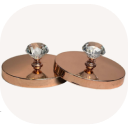Scented Paraffin Candles Pose No Known Health Risks
A 2014 study in the Journal of Regulatory Toxicology and Pharmacology found scented paraffin candles pose no known health risks and that emission levels fall well below World Health Organization exposure limits.
HUMAN HEALTH RISK EVALUATION OF SELECTED VOC, SVOC AND PARTICULATE EMISSIONS FROM SCENTED CANDLES
Abstract
Airborne compounds in the indoor environment arise from a wide variety of sources, such as environmental tobacco smoke, heating and cooking, construction materials, as well as outdoor sources. To understand the contribution of scented candles to the indoor load of airborne substances and particulate matter, candle emission testing was undertaken in environmentally controlled small and large emission chambers.
Candle emission rates, calculated on the basis of measured chamber concentrations of volatile and semi-volatile organic compounds (VOC, SVOC) and particulate matter (PM), were used to predict their respective indoor air concentrations in a standard EU-based dwelling using 2 models: the widely accepted ConsExpo 1-box inhalation model and the recently developed RIFM 2-box indoor air dispersion model. The output from both models has been used to estimate more realistic consumer exposure concentrations of specific chemicals and PM in candle emissions.
Potential consumer health risks associated with the candle emissions were characterized by comparing the exposure concentrations with existing indoor or ambient air quality guidelines or, where not existent, to established toxicity thresholds. On the basis of this investigation, it was concluded that under normal conditions of use scented candles do not pose known health risks to the consumer.
Thomas Petry 1, Danielle Vitale 2, Fred J Joachim 3, Ben Smith 4, Lynn Cruse 5, Reuben Mascarenhas 6, Scott Schneider 7, Madhuri Singal 2
Copyright © 2014 Elsevier Inc. All rights reserved.
Paraffin waxes are separated from crude oil during the production of light(distillate) lubricating oils. These waxes are categorized by oil content and the degree of refinement. The crudest versions fall into the slack wax category and contain between 5% to 20% oil. Next on the step of refinement are scale waxes containing between 1% to 5% oil. The highest grade of refinement is the fully refined wax. Fully refined paraffin waxes contain less than 0.5% oil and have been hydro treated or clay treated to remove impurities and color. The resulting waxes are water clear, odor free, and normally food grade.
Paraffin waxes are used in dozens of applications including:
1: Candle Industry
The candle industry is one of the major sectors for the consumption of refined paraffin wax in the world, it being the preferred material for making candles. Moreover, despite the progressive diversification of wax applications, candle manufacture continues to be the destination of most paraffin wax produced throughout the world.
2: Cosmetic & Pharmaceutic
Paraffin wax is used as an ingredient for lotions, pastes, creams, lipsticks and as a covering for tablets to protect their surface, delay the release of their contents and increase their shine.
Pharmaceutical grade liquid wax (white oil) is also an important product for related products. It is widely used in the products of ointments, skin creams, hair preparations, suntan lotions and emollients, ingredients for baby and bath oils, lotions, lipsticks, massage oils.
3: Food Industry
Paraffin waxes are used in different kinds of foods, such as, for example, covering certain cheeses for surface protection or for producing gum base, a fundamental ingredient of chewing gum.
Chewing gum base is a compound of elastomers, resin and food-grade wax to which other materials are added to produce chewing gum. Hard, high melt-point waxes are used in this application, including microcrystalline and candelilla waxes. It is also used on citrus and other fruit to improve moisture retention, extending its life and freshness and providing shine.
4: Industrial Coating
Paraffin waxes are used as additives in the production of printing inks and varnishes to improve the resistance of the products to friction or scratching or to achieve a certain appearance and to act as a barrier to moisture. It is also used as a ligand material for enamels, lubricating agents, corrosion protection, etc.
5: Textile Industry
Natural fibers contain substances with waxy properties that act as protective agents against atmospheric and biological influences. As they are fibers, these substances are eliminated and the friction and absorption characteristics that they provide are lost, resulting in a loss of softness, flexibility and elasticity, making it necessary to re-apply a suitable finish, provided by paraffin wax among others.
6: Dental Wax
Paraffin waxes and wax blends are formulated to be high quality premium modeling waxes for use in dentistry. The waxes are usually provided by specialty businesses that utilize the paraffin and microcrystalline waxes with other materials to make a finished dental wax
7: Insulating Wax
Paraffin waxes are utilized in numerous electrical applications as a result of their insulating capabilities.
8: Investment Casting
Paraffin and microcrystalline waxes serve as binders in investment casting “waxes” and assist in the removal of the blend after the mold is produced. Investment casting waxes offer exceptional dimensional stability required in precision castings of metals.
9: Leather Treating
Crude scale and paraffin waxes are employed to soften and impart water repellency to leather goods.
10: Metal Coatings
Paraffin and crude scale waxes can be used on the surface of metals during production and shipping to provide lubrication and serve as a protective barrier (acid etching or moisture).
11: Paint and Varnish Removers
Paraffin waxes reduce the evaporation of solvents prolonging their efficiency.
12: Ski Wax
Paraffin waxes permit skiers to achieve much greater speeds through the production of a uniform,
unblemished surface. Waxes are applied to the snow / ski interface to fill all voids in the ski base. The surface wax must be removed as it will actually stick to snow crystals reducing achievable speeds. The finished product is often a formulation of paraffin, microcrystalline, and natural waxes.












